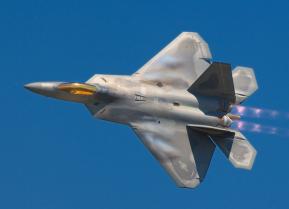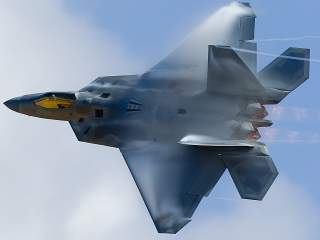Raptor Reborn: Is a Super F-22 Fighter Heading to Japan?
Lockheed Marting is pitching the idea to Tokyo.
It is unlikely that the U.S. Air Force would buy additional F-22s for itself, however.
Reports are once again emerging from Japan that Lockheed Martin is pitching a highly modified version of its stealthy F-22 Raptor air superiority fighter to Tokyo for its next-generation fighter requirement. However, Lockheed Martin would first have to overcome the 1997 Obey Amendment, which prohibits export of the powerful high altitude supersonically cruising stealth fighter. Additionally, the company would have to undertake a painstaking process to restart a production line for an aircraft that has been out of production since 2012.
(This first appeared last month.)
Nonetheless, Lockheed Martin is reportedly willing not only to restart production of a modified F-22, the company is willing to extend significant work share to Japanese industry. “Lockheed Martin has proposed that Japanese companies be responsible for more than half of the development and production of a next-generation fighter jet that Japan wants to introduce in 2030,” Nikkei reports. “Lockheed is offering Japan an upgraded version of the existing F-22.”
As a sweetener to the potential deal, Lockheed Martin is reportedly willing to incorporate avionics built by Mitsubishi Electric and a new wing developed by Mitsubishi Heavy Industries onto the aircraft. Even components such as the fuselage that would be built in the United States would incorporate additional Japanese-made hardware. Potentially, the modified Raptor variant could use Japanese-developed IHI XF9-1 powerplants to replace the jets’ existing Pratt & Whitney F119 engines. “The updates will improve the plane's main wings and allow more fuel to be loaded, increasing the jet's range to about 2,200 km so it can be used to defend isolated islands and other missions,” Nikkei reports.
If the Pentagon, U.S. State Department and the U.S. Congress agree to change the law and allow Japan to restart the F-22 production line, there is some possibility that the U.S. Air Force could benefit from avionics upgrades for the new Japanese Raptors. Based on the threats the U.S. Air Force sees becoming operational in 2019-2020, the service is looking at planning future upgrades for the F-22—however those discussions are classified. But the fact remains that the Raptor’s avionics will need to be completely revamped at some point.
“Sometime between 2025 and 2030 we’re going to have to take a serious look at the supportability of some of the systems onboard the Raptor and upgrading those,” Tom McIntyre, a program analyst for F-22 requirements at Air Combat Command, told The National Interest last year. “We’re currently in the very early stage of looking at that.”
It is unlikely that the U.S. Air Force would buy additional F-22s for itself, however. The aircraft is expensive–with the Japanese variant potentially costing between $188 million and $215 million per jet depending on the order quantities—and the design is dated. Given the sheer cost of the aircraft, it is simply not worth it when there are more important priorities for the U.S. Air Force.
The U.S. Air Force recognizes that potential adversaries like Russia and China are designing measures to defeat the Raptor and American air superiority writ large—and by the time Raptor production were to be restarted, the jet would be largely obsolete in many regards.
“The timeline associated with pursuing F-22 production restart would see new F-22 deliveries starting in the mid-to-late 2020s,” an Air Force 2017 report to Congress reads. “While the F-22 continues to remain the premier air superiority solution against the current threat, new production deliveries would start at a point where the F-22' s capabilities will begin to be challenged by the advancing threats in the 2030 and beyond timeframe. F-22 production re-start would also directly compete against the resources necessary to pursue the Chief of Staff of the Air Force-signed Air Superiority 2030 (AS 2030) Enterprise Capability Collaboration Team (ECCT) Flight Plan, which addresses the critical capabilities required to persist, survive, and be lethal in the rapidly evolving-highly-contested Anti-Access/Area-Denial (A2/AD) threat-environment.”
Recommended: What Will the Sixth-Generation Jet Fighter Look Like?
Recommended: Imagine a U.S. Air Force That Never Built the B-52 Bomber
Recommended: Russia's Next Big Military Sale - To Mexico?
Recommended: Would China Really Invade Taiwan?
As such, the service is proceeding with a developing a Penetrating Counter Air (PCA) fighter. What might happen is that the F-22 would partner with the sixth-generation PCA in a teaming arrangement similar to today’s partnership between fourth and fifth-generation aircraft. The Raptor would take the place of the F-15C Eagle as the lower-tier of a high-low mix with the PCA forming the upper-tier.
“When the PCA comes online, it will be designed to operate and be interoperable with fifth-generation aircraft such as the F-22 and F-35,” McIntyre said. “There will come a time whether it is 2030, 2040 or 2050 when the F-22 will be kind of like a fourth-generation aircraft today.”
Dave Majumdar is the defense editor for The National Interest. You can follow him on Twitter: @davemajumdar.


